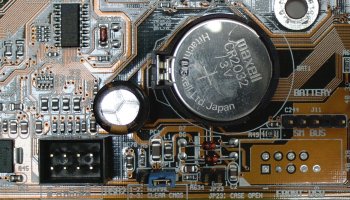Motherboards also include a separate block of memory made from very low power consumption CMOS (complementary metal oxide silicon) RAM chips, which is kept alive by a battery even when the PC’s power is off. This is used to store basic information about the PC’s configuration: number and type of hard and floppy drives, how much memory, what kind and so on. All this used to be entered manually, but modern auto-configuring BIOSes do much of this work, in which case the more important settings are advanced settings such as DRAM timings. The other important data kept in CMOS memory is the time and date, which is updated by a Real Time Clock (RTC).

The CMOS memory is usually located with the real-time clock in the motherboard chipset or in a separate real-time clock chip. The PC reads the time from the RTC when it boots up, after which the CPU keeps time – which is why system clocks are sometimes out of sync. Rebooting the PC causes the RTC to be reread, increasing their accuracy.
In modern-day PCs the nonvolatile BIOS memory is generally an EEPROM or Flash memory chip. There is still a backup battery involved, but its role is not to maintain the data stored in the RAM, only to keep the RTC chip operational.
- Evolution of the motherboard
- BIOS – What motherboard BIOS does for a PC
- CMOS – complementary metal oxide silicon – RAM chips on motherboards
- EFI – Extensible Firmware Interface – explained
- Motherboard form factors
- Baby AT (BAT) Motherboard Form Factor
- LPX – Low Profile eXtension motherboard form factor
- ATX form factor
- NLX – New Low profile eXtended – form factor for motherboards
- Micro ATX motherboard form factor
- FlexATX motherboard form factor
- BTX – Balanced Technology eXtended – Motherboard Form Factor
- Riser architectures for motherboards
- CPU interfaces – motherboard slots and sockets for AMD and Intel processors